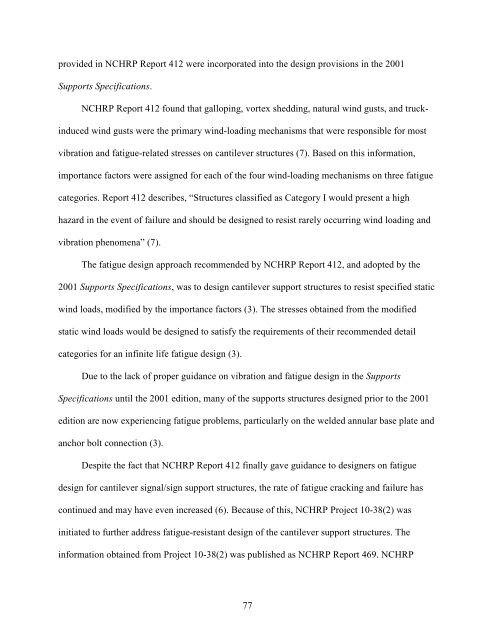Alternative Support Systems for Cantilever - National Transportation ...
Alternative Support Systems for Cantilever - National Transportation ...
Alternative Support Systems for Cantilever - National Transportation ...
Create successful ePaper yourself
Turn your PDF publications into a flip-book with our unique Google optimized e-Paper software.
provided in NCHRP Report 412 were incorporated into the design provisions in the 2001<br />
<strong>Support</strong>s Specifications.<br />
NCHRP Report 412 found that galloping, vortex shedding, natural wind gusts, and truck-<br />
induced wind gusts were the primary wind-loading mechanisms that were responsible <strong>for</strong> most<br />
vibration and fatigue-related stresses on cantilever structures (7). Based on this in<strong>for</strong>mation,<br />
importance factors were assigned <strong>for</strong> each of the four wind-loading mechanisms on three fatigue<br />
categories. Report 412 describes, “Structures classified as Category I would present a high<br />
hazard in the event of failure and should be designed to resist rarely occurring wind loading and<br />
vibration phenomena” (7).<br />
The fatigue design approach recommended by NCHRP Report 412, and adopted by the<br />
2001 <strong>Support</strong>s Specifications, was to design cantilever support structures to resist specified static<br />
wind loads, modified by the importance factors (3). The stresses obtained from the modified<br />
static wind loads would be designed to satisfy the requirements of their recommended detail<br />
categories <strong>for</strong> an infinite life fatigue design (3).<br />
Due to the lack of proper guidance on vibration and fatigue design in the <strong>Support</strong>s<br />
Specifications until the 2001 edition, many of the supports structures designed prior to the 2001<br />
edition are now experiencing fatigue problems, particularly on the welded annular base plate and<br />
anchor bolt connection (3).<br />
Despite the fact that NCHRP Report 412 finally gave guidance to designers on fatigue<br />
design <strong>for</strong> cantilever signal/sign support structures, the rate of fatigue cracking and failure has<br />
continued and may have even increased (6). Because of this, NCHRP Project 10-38(2) was<br />
initiated to further address fatigue-resistant design of the cantilever support structures. The<br />
in<strong>for</strong>mation obtained from Project 10-38(2) was published as NCHRP Report 469. NCHRP<br />
77
















